
Surrounded by the fields and forests that create rolling horse country outside Philadelphia, John Dunigan lives in some of the most beautiful landscape in America. It’s no surprise that the early settlers chose this setting for their new home. And, therefore, it’s no surprise that it’s here, hidden behind the tennis and paddle-ball courts, with a forever view on a day with early fall foliage in full bloom, all shades of greens and yellows and reds, that we found John teaching golf at White Manor Country Club.
John’s first student of the day was a middle-aged man who is athletic, a bit overweight, but in otherwise good shape. For our purposes, we’ll call him “Chris.” At one time, Chris was a regular golfer who was happy to shoot around 100. He had traveled thousands of miles to see John, because his kids are older now, and to get back in the game, he had just purchased a K-PLAYER.
First, John established Chris’s starting point and determined his ambition. As he did this, he had Chris warm up with a workout program pre-built into Chris’s K-PLAYER, designed to activate and loosen all of Chris’s muscles. As they chatted, Chris followed the workout under John’s supervision, using the biofeedback guides to lead him through the general movement patterns and loosening up, with no concern for performing a perfect execution. This is a big part of John’s philosophy: non-judgmental, realistic, and encouraging. When Chris struggled, John told him, “awareness, not judgment; that’s golf.”
“Today, we’re going to swing the golf club, not hit the ball, “John said, placing a wedge in Chris’s hand. “The club will hit the ball; you will swing the club.”
Chris looked at John and nodded.
Then John added, “And to do that, you must know where your hands are. You must be one with the clubhead. The club must become a phantom limb.”
“A phantom limb?” Chris asked.
“Yes, a phantom limb, like a part of you.”
From there, did John have Chris hit balls? No way. John’s next step was to teach Chris how to grip the club the “Dunigan way”:
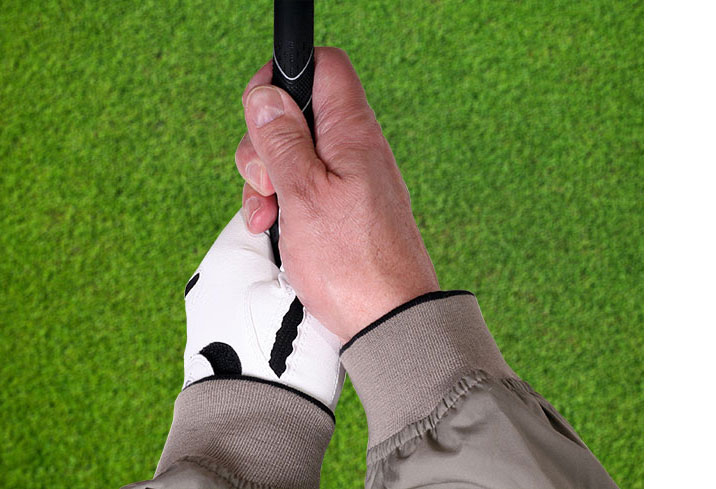
1. Hold the club perpendicular to the ground.
2. Wrap three fingers of the left hand perpendicular to the shaft.
3. Position your hands, so the left thumb is at one o’clock.
4. Cover the left thumb with the right hand like the bun of a hot dog.
John handled these instructions in such a casual way that Chris stayed relaxed. It was very much taken for granted that this was no big deal and quite simple, when, in fact, in less-skilled hands, learning to grip a club can be stressful. John’s manner with his students is casual, confident, and competent. This enables him to build report and trust, which accelerates learning. It looks effortless, but it’s anything but…
Once Chris could grip the club well enough, John reminded him: “It’s a phantom limb. Now make swings to feel the clubhead at the end of your phantom limb.”
Chris confirmed that he could tell where the clubhead was through the entire swinging motion. “That’s great,” John told him. “Close your eyes and do the same thing. Be one with the clubhead, your phantom limb.”
“Open your eyes now,” John said, “I am going to teach you one of the most important parts of the golf swing. Watch me very carefully.” John proceeded to waggle a golf club twice. “It’s called the ‘waggle.’”
“The waggle?” Chris asked, a quizzical look on his face.
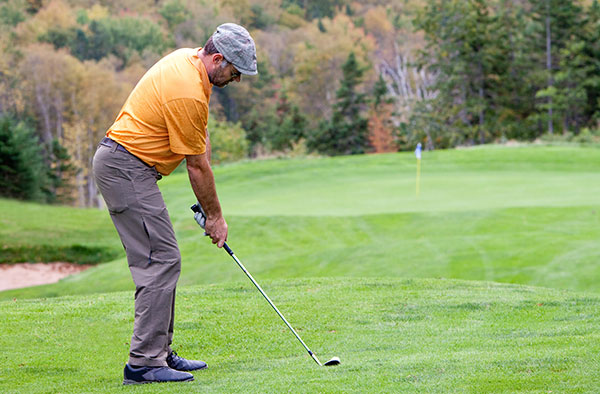
“Yes, the waggle, “John told him. “Never forget it. You do this every time before you hit a ball. You do it to find the clubhead. You can’t play this game if you can’t find the clubhead. The waggle finds the clubhead. When do you do it?”
“Every time,” Chris said, very seriously.
“That’s right,” John said. At this point, he turned to the eight players hitting balls under the morning sun to his right on the grass driving range and said to everyone and no one: “Folks, who’s got a spray can?”
They all stopped, all eight of them. And they all had spray cans and offered them to John. We were clearly in Dunigan territory. John thanked everyone, grabbed the can from the player closest to him, and proceeded to spray the face of Chris’s wedge with the contents of the can… with Dr. Scholl’s foot powder. He returned the can with a thank you.
“Now, I want you to hit the club in the exact middle of the face,” he told Chris. “That’s your only job. Good grip. Waggle. Hit the center of the face.”
“Center of the face,” Chris repeated.
“You’ll know,” John reminded him, “because it will make a mark in the powder. I have 10-year-old kids who can make a quarter-size mark in the exact middle, every time. It’s not hard; it just takes practice.”
Chris set to hitting balls for the first time all day, his only instructions: Hold the club the Dunigan way, waggle, and hit the center of the club.
It’s not easy,” Chris told John.
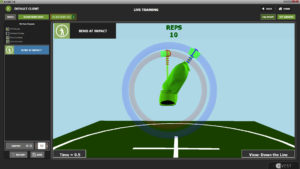
“You know what the word for “practice” is in Russian?” John asked, with a big grin on his face. “Struggle. Really, it’s struggle. If you want to get good at anything, you have to willingly, happily struggle.” Chris smiled too, took his grip, did his waggles, and tried to hit the center of the club face. Slowly, he improved.
Now that John had warmed up his golfer, taught him to use his hands, and had him hitting the center of the club, the next step was to teach his golfer how to move athletically. This he did by placing Chris on an angled piece of plywood covered in worn Astroturf. “Time to learn to move,” John said. “Get in an athletic position, but not in golf posture.”
Chris did it.
“Stand tall. Turn your hips back as on a backswing. Then press your left hip forward as if toward the target, then turn your hips toward the target, and stand tall as you turn as if you were going to touch the sky.”
John supervised Chris setting up on the Astroturf ramp, putting all his weight on the back foot, and then really turning into the uphill side of his body and around it to transfer his weight to the uphill foot. When Chris could do this well enough, John had him do the same thing on flat ground. He then used “set live” in the K-PLAYER biofeedback software to save the exact motion he wanted Chris to make.
John had Chris practice this a few times, following the avatar and the dings provided by the biofeedback software. This enabled Chris to practice the exact movement pattern John had created on the hill with him. “Every day,” John told Chris. “Three sessions of just 10 repetitions of this, and you will master it. Got it? Ding and move. Move and ding.”
Chris nodded.
“Good,” John said, “That’s your movement drill. Now, let’s swing the club a bit more.”
John next placed Chris in a proper setup at address to the golf ball. He saved that position, using the advanced posture at address activity in the K-PLAYER. “Now, every time you set up to a golf ball, it will be like I am there with you, “John told Chris.
“This time,” John told him, “grip the club, hear the ding from the biofeedback that your posture is good, waggle, ding, and swing. And you can only really learn one or two things in a swing, so when you are swinging, what do you do?”
“Hit the center of the club,” Chris told him.
“Very nice,” John told him, pleased with his student’s learning. “Waggle, ding, and swing.”
What was interesting is that with no reference to the drill they had just performed, John had Chris moving much better and hitting the ball better. So well that at some point John turned on the Trackman and handed Chris a driver rather than a wedge, and boom ― a clubhead speed of 100 miles an hour. On the best ones, John achieved a carry of 250 yards ― all this from a guy who had arrived with almost no golf swing. The one problem, though, he had a bit of a hook.
Now John put on the other two sensors that transform a K-PLAYER into a K-VEST, so he could capture a swing. K-PLAYER only trains movement. K-VEST trains, and it also measures with the precision of a medical device. John put one sensor on Chris’s glove and another on the bicep of Chris’s left arm, his lead arm. He had Chris stand tall and recalibrated him. It took less than a minute. Then he said, “Just hit some more balls.”
As Chris waggled, dinged, and swung to hit balls, the auto capture feature performed just as it should: It captured all the swings.
When John had captured somewhere between five and 10 of Chris’s swings, John pulled up the multi-swing report and kinematic sequence chart in K-VEST. From the reports, John saw that Chris’s torso was rotating more than 100 degrees. According to John, this rotation caused Chris to swing overly to the right with his club and hit the ball with the toe of the club. The result was a hook.
From the reports, it was clear to John that Chris’s side bend and bend at the top of his backswing were inconsistent and connected to the over-rotation. Noticing that Chris hit his best shots with better side bend and bend , John decided to work on those to determine if that didn’t sort out the over-rotation and the hook. “All we do to start is identify the pattern in the metrics that is consistent in the best balls you hit,” John told Chris.
John then programmed that pattern into the K-VEST software’s advanced upper body at the top activity. This would alert Chris when Chris found the position John wanted him in at the top of the backswing.
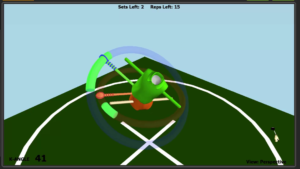
“Set up, waggle, ding, and swing,” John told Chris.
John used this activity in the K-VEST to help Chris shorten his turn. A quick glance at his Trackman told John that Chris’s club speed did not diminish, while his path came down to 4, and the contact was more in the center. Most importantly, the ball started flying straighter and just as far.
“Set up, waggle, ding, and swing,” John told Chris again.
“Wow, this is unbelievable,” Chris said after one very pure strike and then caught himself in his enthusiasm. “But they aren’t all going totally straight.”
“Trust me. You are doing great. You are doing greater than great. The PGA average for a greens hit in regulation is 12 per round. The tour leader is at 72 percent. Around 13.”
“So what do I do?”
“Know the facts and manage your expectations. Jack Nicklaus expected to miss one out of every three shots.”
“Really?”
John’s next student had arrived.
“Yup, manage your expectations, and practice. And we can guarantee you will be inconsistent.”
Remember, the best players in the world are not the most consistent ones, but the ones who manage their inconsistencies the best.”
After a very big thank you, Chris turned to me and said, “That was unbelievable.”
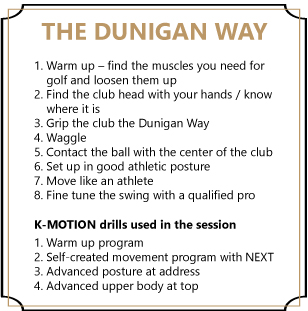
As John got to work on the next student, Chris packed up his K-PLAYER and clubs, remarking, “best lesson I ever took.” “I am so lucky to have him as my teacher.”
He said “teacher” rather than “golf teacher” because John is a great teacher who just happens to teach golf.
“I think I am going to go home and practice some more,” Chris told me as he headed toward his car.
This lesson was on Saturday. Chris did not practice again that day. Instead, he ate a Philly cheesesteak at Pat’s. The next day, he watched the Eagles game and then got on an airplane and traveled for 17 hours.
The following day he played golf.
Afterwards, he sent the following text message: “Just played nine holes to try things out,” he wrote. “Except for hole one, which was 3 over, I played the balance eight at 1 over. It’s just nine holes. I’ll be back to regular service on my next round of 24 over. Ha… Ha… Ha… But, I tell you, this technology works. The tech combined with a fantastic specialist like Dunigan is an absolute winner.”
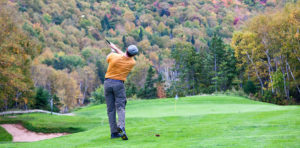
The MLB Winter Meetings brings together baseball executives, coaches, media, exhibitors and job seekers from around the world to network, fill job openings, attend educational workshops and discuss innovating trends in the industry. It’s one of the highlights of our…
Agreement to Accelerate Improvement Across All Levels of the Organization (SCOTTSDALE, Ariz.) K-MOTION – the leader in 3D evaluations and biofeedback training solutions for coaches and athletes – announces an agreement with the Baltimore Orioles to become the organization’s Player…
By Joe DiChiara and Jason Meisch You take a swing and don’t like where the golf ball goes. You want to know what happened, so you turn to your launch monitor. You look at the club face numbers. They tell…